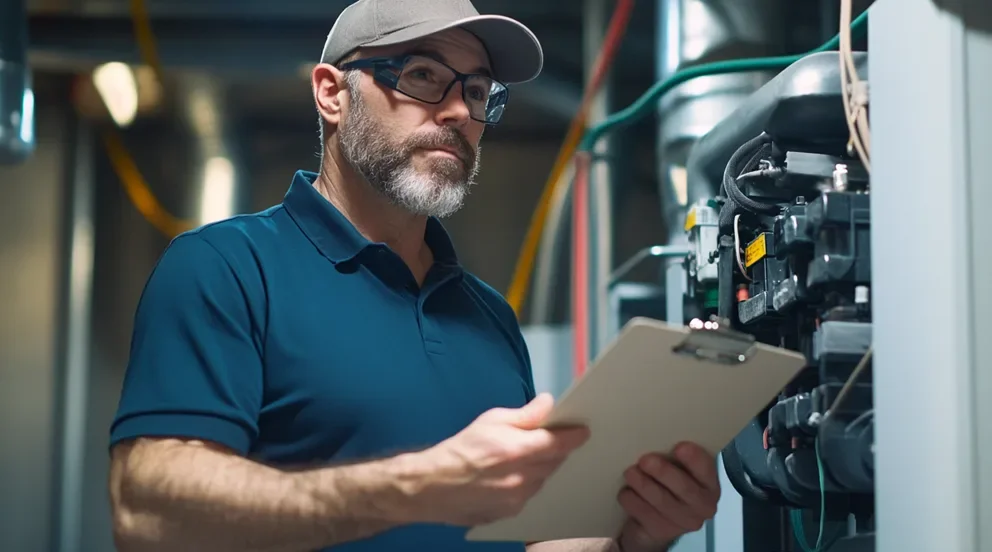A dual-fuel heat pump is an energy efficient heating and cooling system that combines an electric heat pump with a gas furnace. It is designed to provide an efficient and cost-effective way to heat and cool a home. The heat pump component of the system is used primarily for cooling the home during the summer months and for providing supplemental heat during the winter months. The gas furnace component of the system is used for providing the majority of the home’s heating during the winter months.
The dual fuel heat pump uses two separate systems to heat and cool a home. During the summer months, the electric heat pump component is used to cool the home by transferring heat from the inside of the house to the outdoors. During the winter months, the heat pump component is used to provide supplemental heat by transferring heat from the outdoors to the indoors. The gas furnace component provides the majority of the home’s heating needs during the winter months.
The dual fuel heat pump system is ideal for homeowners who want an energy efficient way to heat and cool their home. The system is designed to use the most energy efficient component depending on the season and weather conditions. The system also allows homeowners to set their desired temperature for the home, and the dual fuel heat pump will automatically switch between the two components to provide the most cost-effective and comfortable temperature for the home.
In addition to being energy efficient, the dual fuel heat pump system is also very quiet and efficient. The gas furnace component of the system runs very quietly, while the heat pump component operates quietly and efficiently. This makes it an ideal choice for homeowners who want an energy efficient and quiet system for their home.
What are the benefits of using a dual fuel heat pump?
A dual fuel heat pump offers several advantages to homeowners who are looking for an energy efficient way to heat and cool their home. The primary benefit of a dual fuel heat pump is its ability to provide an efficient and cost-effective way to heat and cool a home. The system is designed to use the most energy efficient component depending on the season and weather conditions. This allows homeowners to set their desired temperature for the home, and the dual fuel heat pump will automatically switch between the two components to provide the most cost-effective and comfortable temperature for the home.
Another benefit of a dual fuel heat pump is its quiet and efficient operation. The gas furnace component of the system runs very quietly, while the heat pump component operates quietly and efficiently. This makes it an ideal choice for homeowners who want an energy efficient and quiet system for their home.
Finally, a dual fuel heat pump provides homeowners with greater flexibility in controlling their home’s temperature. The system allows homeowners to set their desired temperature for the home, and the dual fuel heat pump will automatically switch between the two components to provide the most cost-effective and comfortable temperature for the home. This provides homeowners with the ability to keep their home at a comfortable temperature year-round.
What type of temperature control does a dual fuel heat pump provide?
A dual fuel heat pump provides temperature control by automatically switching between two components to provide the most energy efficient and cost-effective way to heat and cool a home. The system is designed to use the most energy efficient component depending on the season and weather conditions. The electric heat pump component is used primarily for cooling the home during the summer months and for providing supplemental heat during the winter months. The gas furnace component of the system is used for providing the majority of the home’s heating during the winter months.
The dual fuel heat pump system allows homeowners to set their desired temperature for the home, and the dual fuel heat pump will automatically switch between the two components to provide the most cost-effective and comfortable temperature for the home. This provides homeowners with the ability to keep their home at a comfortable temperature year-round. In addition, the system will automatically adjust the temperatures for different parts of the home to ensure that the desired temperature is maintained throughout the entire house.
The dual fuel heat pump system also provides homeowners with greater flexibility in controlling their home’s temperature. The system allows homeowners to set their desired temperature for the home and the system will automatically adjust the temperature as needed to provide the most comfortable and cost-effective temperature for the home.
What are the advantages of the dual fuel heat pump over a single-source heating and cooling system?
The dual fuel heat pump offers a number of advantages over a single-source heating and cooling system. The primary advantage is that the dual fuel system is more energy efficient than a single-source heating or cooling system. This is because the dual fuel system utilizes two sources for providing heat and cool air, allowing it to select the most efficient source depending on the season and weather conditions.
In addition, since the dual fuel heat pump uses two separate components for heating and cooling, it provides greater flexibility in controlling temperature throughout the home. The system allows homeowners to set their desired temperature for each part of their home, and the system will automatically adjust temperatures as needed to provide comfort throughout the entire house.
Finally, another advantage of a dual fuel heat pump is its quiet and efficient operation. The gas furnace component of the system runs very quietly, while the heat pump component operates quietly and efficiently. This makes it an ideal choice for homeowners who want an energy efficient and quiet system for their home.
What are the possible drawbacks of using a dual fuel heat pump?
While the dual fuel heat pump offers numerous advantages over single-source heating and cooling systems, there are some potential drawbacks. The most notable drawback is that the initial cost of installing a dual fuel system can be high since it requires two separate components. Additionally, due to the complexity of the system, repairs or maintenance may require more specialized expertise than a single-source heating and cooling system.
In addition, while the dual fuel heat pump provides greater flexibility in controlling temperature throughout a home, it also requires more frequent adjustments in order to maintain optimal temperatures. This can be somewhat time-consuming as compared to maintaining a single-source HVAC system.
Finally, another possible disadvantage of using a dual fuel heat pump is that the system may not be ideal for climates that experience significant temperature swings throughout the year. In these cases, a single-source heating and cooling system may be more effective in providing consistent temperatures throughout the home.
What type of maintenance is required to keep a dual fuel heat pump system running efficiently?
In order to keep a dual fuel heat pump system running efficiently, it is important to properly maintain and service the two components of the system. The gas furnace should be serviced annually by a professional technician in order to ensure that all parts are functioning correctly and that there are no safety hazards. The heat pump component requires regular cleaning and maintenance as well, including cleaning or replacing air filters, checking for any potential leaks, and making sure all connections are secure.
It is also important to regularly check the temperature setting on both components to make sure they are adjusted correctly. Finally, it is advisable for homeowners to periodically inspect the interior and exterior of their home for any potential drafts or other sources of energy loss. This will help ensure that the dual fuel heat pump system is able to provide optimal temperature control and energy efficiency.
What kind of energy savings can be expected from using a dual fuel heat pump?
The energy savings from using a dual fuel heat pump system can vary depending on a variety of factors such as the size and efficiency of the system, the climate in which it is located, and how well it is serviced and maintained. However, studies have shown that dual fuel heat pumps typically offer up to 25% savings compared to single-source heating and cooling systems. This can result in substantial cost savings for homeowners over time, especially in climates where temperatures swing significantly throughout the year. In addition, due to their quiet operation and ability to provide consistent temperatures throughout the home, dual fuel heat pumps typically offer greater comfort levels than other HVAC systems.
What types of climates are best suited for a dual fuel heat pump?
Dual fuel heat pumps are best suited to climates that experience moderate temperature swings throughout the year. In these types of climates, a dual fuel system is able to provide efficient and consistent temperatures while also offering the flexibility of being able to switch between heating and cooling sources as needed. Dual fuel systems are also ideal for colder climates since they provide an additional source of backup heat in case temperatures drop too low. Additionally, because they operate quietly and efficiently, dual fuel heat pumps can be beneficial in urban settings where noise levels may be higher than in more rural areas.
Are there any special installation requirements for a dual fuel heat pump?
Yes, dual fuel heat pumps require special installation considerations in order to ensure that they can operate safely and efficiently. It is important for the gas furnace portion of the system to be installed correctly in order to prevent any potential safety hazards. Additionally, the heat pump unit should be installed according to local building codes and must have access to an adequate amount of outside air in order for it to function properly. Finally, a professional technician should be consulted during installation in order to ensure that all connections are secure and that both components are set up correctly. This will help maximize the energy efficiency of the system and reduce the risk of potential problems down the line.



